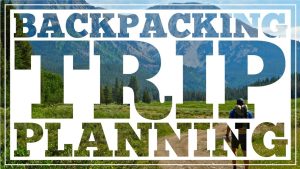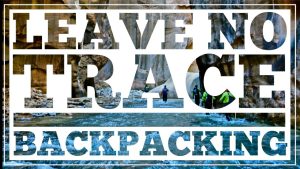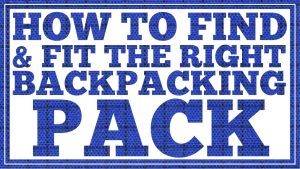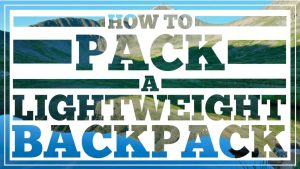Ep. 11 – Emergency First Aid Skills for the Backcountry
Some of the links on this page are affiliate links
Emergency First Aid Skills for the Backcountry
I’m Dave Collins with CleverHiker.com and in this episode we’re going to take a look at some of the most important first aid skills for the backcountry.
Knowing what to do in an emergency when you’re miles away from help is just about as important as backcountry skills get.
You’ll hopefully never have to use them, but emergency first aid is skills can literally safe your life or the life of your backpacking partner, so don’t overlook them.
Even though first aid skills are obviously critical, many backpackers venture into the wild without even the most basic level of understanding of wilderness first aid.
So, in this episode we’re going to address some key wilderness first aid skills for every backcountry traveler to know by heart.
It needs to be said though, that there’s really no way to properly learn all of these critical skills from watching a short video.
We can give you key information, but we can’t properly prepare you for wilderness first aid and we can’t give you the practice you’ll need in a wilderness emergency.
That’s why I highly recommend signing up for a wilderness first aid course to hone your skills and get the experience you need to be prepared for a backcountry emergency.
Wilderness first aid is way too important to take lightly, so put in the time to become an expert and you’ll be much better prepared.
—
There are a few things to remember in every emergency situation, the most important of which is to remain calm.
Your ability to assess the situation rationally, develop an emergency plan, and deal with the circumstances confidently is crucial to your success.
Before your trip, talk with your group about the best way to deal with emergency situations and how to utilize any resources that are available to you.
You should know what your options are for emergency help. You can send a hiker to get help or bring a cell phone, emergency beacon, or satellite phone to contact assistance.
In an emergency situation, reduce your exposure, stay warm, and stay hydrated. If there is an injured member in your group, don’t leave them alone if at all possible.
Also, prevent the spread of disease and infection by taking precautionary measures, like washing your hands or wearing protective gloves when there is a possibility of touching blood or other body fluids.
Remember, dealing with emergencies calmly, rationally, and efficiently will be your best chance for success in the wilderness.
—
CPR:
CPR, is an emergency procedure that is performed on people experiencing cardiac arrest. Simply put, CPR saves lives.
The puropus of CPR is to provide oxygenated blood flow to the brain until the victim’s heartbeat and breathing are restored.
In order to be properly prepared to give CPR, I highly recommended that you take a CPR course and get certified to give CPR.
Before you approach any victim, it’s important to scan the scene to make sure it is safe to approach and won’t put you in danger as well.
The first step in CPR is checking to see if a person is unresponsive and not breathing, or is breathing abnormally. (look, listen, feel)
If the person is unresponsive, call for help if possible, or send someone to call for help, and begin CPR.
Roll the person on their back and begin chest compressions immediately.
Even if you’re not confident enough to perform rescue breathing, you should still perform chest compressions, which are an incredibly important part of CPR.
Place the heal of your hand on the center of the victim’s chest, put your other hand on top with your fingers interlaced, and compress the chest 2 inches 30 times.
Pump hard and fast at a rate of at least 100 compressions per minute, faster than one per second. The song “staying alive” by the Bee Gees is used as a good reminder for the correct beat.
Then, open the victim’s airway by lifting the chin and tilting the head back.
Pinch the nose and cover the victim’s mouth with yours and blow until you see the chest rise. Give 2 quick breaths that last about 1 second each.
Continue with 30 compressions and 2 breaths until help arrives or until you no longer can perform CPR due to exhaustion.
—
Hypothermia:
Hypothermia happens when a person’s core body temperature falls below normal levels, which can happen when a person is exposed to cold temperatures, wind, and wetness.
Hypothermia is one of the most dangerous emergency conditions that can happen in the outdoors and one of the main causes of death to backcountry travelers.
For that reason, it’s important to take the signs of hypothermia incredibly seriously and treat it quickly.
Improper planning, inadequate protection from exposure, and lack of proper hydration and nutrition can all increase your chances of hypothermia.
The first sigh of hypothermia is shivering, which is a symptom of the body trying to warm itself.
Shivering might start mildly, then become more aggressive, and it will eventually stop altogether.
Another sign of hypothermia is referred to as having a case of the umbles, meaning the mumbles, fumbles, grumbles, and stumbles.
Hypothermia victims may slur their speech, lose their coordination, become confused, and will eventually become apathetic and irrational.
To treat hypothermia, get the victim to out of the elements, get them dry, and warm up their core body temperature as soon as possible.
Get the victim to shelter and replace wet base layers with dry clothing.
If the victim is conscious, feed them caloric drinks and food to boost their metabolism and have them exercise in short bursts to generate heat. Avoid caffeine and alcohol.
If the victim is unconscious, be very gentile with them because their heart will be sensitive and don’t try to give them fluids or food because they may choke.
Put the victim in a sleeping bag on top of a pad to insulate them from the cold ground. If possible, wrap the bag with a plastic sheet or tarp for more insulation.
Sharing body heat with skin-to-skin contact can be a good way to help a hypothermic victim to warm up as well.
Try to warm the victim’s core first, not their hands and feet, because that will circulate cold blood back to their core.
—
Heat Exhaustion:
Heat exhaustion is a condition that happens in hot climates when a person’s body becomes unable to properly cool itself.
Heat exhaustion can happen when temperatures and humidity are high and your body is working hard.
Dehydration can make matters a lot worse but you might experience heat exhaustion even if you are drinking water in very hot conditions.
Heat exhaustion is not life threatening, but if it goes untreated, it can become heat stroke, which can damage the brain and can lead to death.
Symptoms of heat exhaustion include profuse sweating, weakness, pale skin, nausea, vomiting, headache, and muscle cramps.
To treat heat exhaustion, find a cool, shady location and rest the victim. Lay the person down and elevate their legs slightly.
Give the victim sips of cool water or an electrolyte solution and help them to cool down with a wet bandana compress.
If a victim is experiencing heat stroke their skin will often be red, hot to the touch, and dry because their body temperature is very hot.
Other symptoms of heat stroke include nausea and vomiting, rapid breathing and heart rate, throbbing headaches, confusion, and unconsciousness.
When a victim is experiencing heat stroke their body needs to be cooled immediately and they need to get to medical attention as soon as possible.
Get them to a shady area, remove their clothing, and actively try to cool their body with cool water and wet cloths on their head, neck, armpits and groin.
If possible, have the victim drink cool water or an electrolyte solution. Get them out to medical attention as soon as possible.
—
Minor Wounds and Burns:
Knowing how to properly treat minor wounds and burns in the field is important and will allow you to hike out safely without any lasting effects.
For abrasions, scrub the wound with soap and a clean gauze pad to get out any dirt in the wound.
Rinse off the soap, apply a layer of antibiotic ointment to a gauze pad and tape it in place to completely cover the wound.
The same procedure should be used for minor cuts. If the cut is bleeding a lot, use the gauze pad to apply firm pressure to the wound for around 10 minutes, which will help stop the bleeding.
Then, clean the cut, apply antibiotic ointment and bandage it. Use butterfly bandages to close large cuts and cover the area with a gauze pad to keep it clean until you can get medical help.
For small burns, immediately put the burned limb in cold water, or cover it with a water soaked bandana.
Keep it cool until the pain is reduced, then cover it with a gauze pad. Do not pop any blisters if they form.
Instead, try to keep them from popping as long as possible because the skin is raw and healing underneath the blister.
For second and third degree burns that cover a large surface area, do not immerse the burn site in cold water because that can cause shock.
Cover a serious burn with a cool, moist, sterile bandage, raise the burn site above heart level if possible, and get the victim out to medical help as soon as possible.
If clothing is ever burned along with the skin, don’t pull it off because that can pull off the skin too. If the burn is small enough, you may be able to remove burned clothing after the site has cooled.
—
Heavy Bleeding:
With a heavy bleeding wound, the most important concern is to stop the bleeding and get the victim out to help as soon as possible.
Whenever possible wash your hands and wear vinyl gloves before treating a victim’s heavy bleeding wound to reduce the chance of infection.
Have the victim lie down and cover them to prevent loss of body heat. If possible, elevate the legs slightly and elevate the bleeding site.
Remove any dirt and debris from the wound but don’t remove any large or deeply embedded objects.
Apply pressure directly to the wound until the bleeding stops. Use sterile bandages or clean cloths and keep pressure on the wound for at least 20 minutes without checking to see if bleeding has stopped.
Don’t remove the gauze or bandages. If the bandages get soaked through with blood, add more absorbent bandages on top and continue to put pressure on the wound.
If you’re still having trouble stopping the bleeding, locate the nearest artery and place pressure on it with your fingers. Keep pressure on the wound with your other hand.
Pressure points are just above the elbow and just below the inside of the armpit in the arm. In the leg, pressure points are in the groin and behind the knee.
Immobilize the injured body part once the bleeding has stopped keeping the bandages in place and get the victim out to emergency help as soon as possible.
—
Broken Bones and sprains:
For sprains in the backcountry, the RICE method still applies and is effective. Rest, Ice, Compression, Elevation.
Rest the sprained limb, reduce the swelling by icing with snow or cold water for 20 minutes, then let the limb warm naturally for 20 minutes.
Compress the injury with an elastic bandage and elevate it to keep swelling down. After a few icing cycles you will likely be able to hike out on a sprain.
Use anti-inflammatory drugs like naproxen sodium and ibuprofen to reduce swelling and pain. Also, you can use a makeshift crutch to keep weight off the injury.
A break can sometimes be hard to diagnose. If the injury is swollen, painful, and the limb cannot be used, treat it like a break and splint it.
The best way to treat a break in the backcountry is to immobilize it with a splint so it doesn’t move around and cause more damage. Then get the victim out to medical help ASAP.
To make a splint, improvise by using materials from your backpack and your surroundings. Sleeping pads, trekking poles, sticks, and extra clothing can all be used to make effective splints.
In most cases it’s best to leave a fractured limb in the position you found it, but in a situation where you’re many hours or days away from medical help, you may have to reset the fracture before transporting the victim.
First, stop any bleeding if present. If the break is protruding, you’ll need to push it back into place. This will be very painful but it’s necessary to stop bleeding and prevent infection.
Once the limb is back in the anatomically correct position it will cause less pain and do less damage. Then the limb can be splinted and you can focus on getting out to help.
If a victim may have a spinal cord injury from a fall, a blow to the head, it’s important not to move them unless absolutely necessary.
Keep the victim still and prevent their head from moving until help arrives. Provide first aid if necessary including CPR, but do not move the victim’s head or neck.
If you have to move them because they are vomiting, choking, or are in other danger, use at least one other person to help roll them on their side while keeping their head, neck, and back aligned.
—
Treat shock
Shock is a condition that can accompany trauma, blood loss, heat stroke, an allergic reaction, and other ailments.
Shock occurs when the victim is not getting enough blood and oxygen to their organs and it can lead to permanent organ damage and death.
A person experiencing shock may have cool and clammy skin. Their blood pressure will likely be low and their pulse will be weak and rapid. They may be breathing shallow and rapidly as well.
The person may seem weak with vacant eyes and they might be disoriented and confused. Shock victims can sometimes be nauseous and may vomit as well.
When a person is in shock it’s critical to get them to medical attention as soon as possible. If you can, call for help or send a member of your party to get help.
If someone is experiencing shock, lay them down and elevate their feet about a foot unless their head, neck, back, or legs are injured. Do not raise the victim’s head. The focus is to keep blood in their vital organs.
Check for signs of breathing and begin CPR if necessary. Turn the victim on their side if they are vomiting or bleeding from the mouth.
Treat any obvious injuries like heavy bleeding or broken bones as soon as the person is stable.
Keep the victim warm and comfortable by covering them with a sleeping bag and reducing any restrictive clothing.
Don’t give the victim anything to eat or drink. Keep them still and wait for help to arrive.
—
Remember, the key to wilderness first aid is being properly prepared, staying calm, determine an emergency plan, and acting efficiently.
Hopefully you’ll never have to use wilderness first aid techniques, but if you do, it will be important for you to have the correct knowledge and preparation.
That’s why we highly recommend that you take a wilderness first aid course and CPR course to get certified for emergency situations.
Then, if an emergency ever does happen in the backcountry, you’ll be happy that you have the correct training.
I’m Dave Collins with cleverhiker.com. Hike light, hike smart, and have fun.
MORE EPISODES IN THIS SERIES
View all





